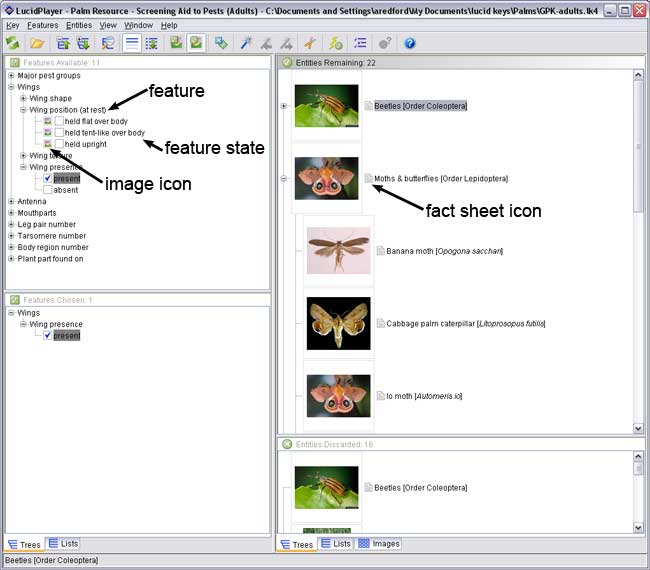About the keys
How to use the keys
SAP includes two interactive keys: one to adults and one to beetle, moth, and butterfly larvae. Clicking on the Keys link will take you to a page to help you decide which key you should use.
The interactive matrix keys are quite different from traditional dichotomous keys. The user is recommended to consult Best Practices on occasion to pick up new tips and tricks for using the interactive keys.
This tool offers a Javascript-based interactive matrix key built using Lucid3 software. Lucid3 is software for creating and using interactive identification keys. Lucid is developed by Identic in Brisbane, Australia. Visit the Lucidcentral website for more information on Lucid and Lucid3.
Any modern web browser can be used, such as Internet Explorer, Firefox, Chrome, or Safari. Javascript must be enabled.
Note also that web pages such as fact sheets attached to items in Lucid3 keys may be considered pop-ups by certain browsers (such as Internet Explorer) when clicked on by users. If your browser blocks these pop-ups, you should allow pop-ups for this Lucid tool in your browser's Internet settings.
A Lucid key has four panels.
- The upper left window Features Available lists the identification features and feature states to choose from.
- The upper right window Entities Remaining lists the available taxa.
- The lower left window Features Chosen lists which feature states are currently selected.
- The lower right window Entities Discarded lists the taxa that have been discarded based the features that have been selected.
Because of the diverse nature of the taxa included in SAP, Lucid's dependencies and scoping features were built into the key. First, users are presented with features that can be used to help narrow in on which order(s) their specimen may belong to. As the Entities Remaining list becomes smaller, features only applicable to those particular groups will begin to appear in the Features Available panel. In this way, the user will not be distracted by features that may not apply to their particular specimen. There is also a feature called Major Pest Groups which allows users who know to which pest order their specimen belongs to go directly to the features that apply to that group.
Both the features and entities have been grouped into hierarchical trees for this tool. The entity trees make the tool particularly useful for training, as the user can follow the higher level taxonomy of their specimen and see which features may be shared between groups of arthropods.
Feature and entity trees can be expanded by clicking the "+" next to the grouping feature or entity. Feature states are selected by clicking checkbox next to the state. Clicking the state a second time deselects the state. As feature states are selected, the entities that do not have those features will be moved into the Entities Discarded panel.

All entities and some feature states are illustrated with drawings and/or photographs. Clicking on the image thumbnail (or image icon if thumbnails are not displayed) brings up a larger size image and gives the user access to the full image gallery for the feature state or entity, if available. All entities are also linked to HTML pages containing fact sheets for the taxon. Clicking the small grey page icon next to the entity thumbnail will open the fact sheet in a new browser window.
In the key itself, common language terms are used to help support use of the key by inexperienced individuals. However, in order to maximize their value and validity, some specialized entomological terminology appears in the fact sheets. A glossary linked to from the fact sheets is provided to assist the user in understanding such terms. An illustrated glossary for insect anatomy is also included.
Multiple states of a feature may be selected. For instance, if a specimen has antennae that are both clubbed and elbowed, both states may be chosen. If unsure of the correct state, it is often better to try a different feature before selecting a state you are unsure about. For more hints on navigating the key, see Best Practices.


